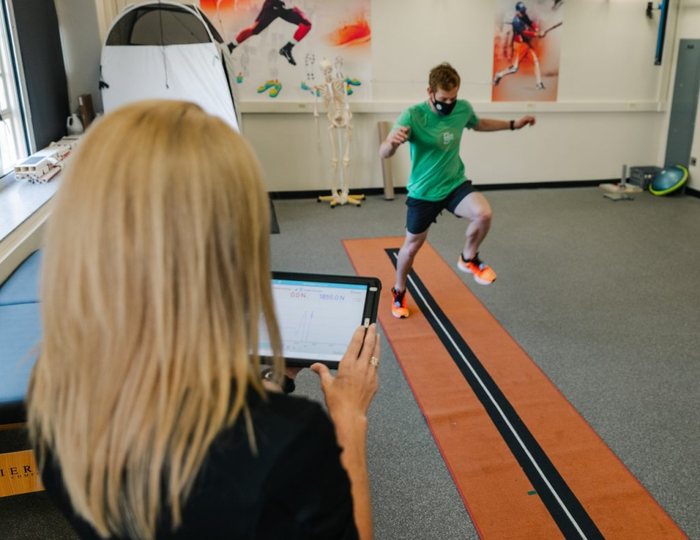Each year, the number of people wearing smart watches increases, according to recent surveys. These wearable sensors are commonplace and provide useful feedback to individuals about their health. Wearable sensors can also be used in labs and clinics to gain real-time data and inform health decisions.

Credit: Virginia Tech
Each year, the number of people wearing smart watches increases, according to recent surveys. These wearable sensors are commonplace and provide useful feedback to individuals about their health. Wearable sensors can also be used in labs and clinics to gain real-time data and inform health decisions.
Supported by a $2.9 million grant from the National Institutes of Health and led by Robin Queen, the Kevin P. Granata Faculty Fellow and professor of biomedical engineering and mechanics, a team of researchers from Virginia Tech and the University of Virginia will assess second anterior cruciate ligament (ACL) injuries — a tear of the same ACL or of the ACL in the other knee — using wearable sensors. Aided by this technology, the multidisciplinary, multi-institutional team aims to develop a model that will allow for the identification of those who are at risk for a second ACL injury when they are released to return to sports.
“The assessment of most of these measures has been completed in research facilities for years, with no way of translating this work into the clinical setting,” said Queen, who is also a faculty member of orthopaedic surgery at the Virginia Tech Carilion School of Medicine and an adjunct faculty member at the Edward Via College of Osteopathic Medicine. “With the advancement of wearable technologies, we are finally in a position to complete this work in the clinical setting. We will be able to provide clinicians with actionable insights on which patients are ready to return to sports and which patients may need additional rehabilitation to decrease the risk of suffering a second ACL injury.”
In a recent study published by Queen, 90 percent of athletes with an ACL injury will undergo ACL reconstruction, at an estimated cost of $3 billion annually. Additionally, athletes who have suffered an ACL injury have a 15-fold increased risk of a re-injury upon returning to the sport.
Queen and her colleagues aim to advance post-ACL reconstruction clinical care by combining traditional clinical and novel clinic-based measures to identify patients at risk for second ACL injuries as they return to sport. The novel measures they assess will be interdisciplinary, including load asymmetry analyzed using the wearable sensors in a variety of sport-specific tasks, as well as psychological readiness and fear of re-injury. They hope to apply the risk model they develop from their data in clinical settings, to help decrease the number of second ACL injuries.
An interdisciplinary approach: analyzing physical and psychological risk
In her lab, the Kevin P. Granata Biomechanics Lab, Queen’s research in musculoskeletal biomechanics takes an interdisciplinary approach to bridging gaps between foundational engineering, patient care, and the development of tools. With this emphasis on interdisciplinary research, she intends to work with others to analyze both physical and psychological risk factors in ACL re-injury.
In the first phase of the project, Queen and her colleagues will evaluate load asymmetry — unequal force or weight being absorbed by one limb, with a greater force being applied to the non-surgical side — using insole sensors. They will collect the data from recruited patients who have undergone only one ACL reconstruction and have been cleared for return to sport. The information collected will be used in their prognostic model for predicting risk of re-injury.
“Second ACL injuries are common in athletes returning to the sport or unrestricted physical activity,” Queen said. “Athletes have residual muscle weakness and asymmetrical loading and movement patterns after an ACL injury. Including load asymmetry in prognostic models would be an important measure in predicting risk of re-injury.”
To factor in psychological risk, Thomas Ollendick, University Distinguished Professor of Psychology in the College of Science, will research the impact of fear and anxiety of re-injury and the locus of control – how strongly people believe they have control over situations and experiences that affect their lives — as it relates to ACL injuries and the recurrence of such injuries. This psychological data will be assessed as one potential risk factored into the prognostic risk model.
Laura Sands, professor of human development and family science, and Pang Du, associate professor of statistics, were essential in the development of the model framework, Queen said. Together, Sands and Du will work to develop a highly accurate prognostic model that can be feasibly implemented into clinical practice. The model will assess risk for a second ACL injury within the year after an athlete with a first ACL tear has been cleared by their physician to resume participation in a sport.
“Prognostic modeling is used extensively in clinical research to determine characteristics that increase risk for poor future health outcomes,” said Sands. “The purpose of prognostic monitoring is to identify patients who would benefit from additional monitoring and preventive interventions to reduce their risk for poor health outcomes.”
Through the assessment of several factors — traditional clinical measures, load symmetry, and psychological factors — this multidisciplinary team will be uniquely positioned to provide clinic-based assessment methods that can be utilized in the treatment and prevention of secondary ACL injuries, Queen said.
“Injury risk factors are incredibly complex and in a lot of ways individualized to the patient,” said Queen. “Using a combination of important factors, this team will be able to develop a model with the ability to identify patients at risk for an injury, and determine who might need to remain in physical therapy versus those who can safely return to sport. These results will also provide clarification on the role of both physical and psychological readiness to return to unrestricted activity.”




